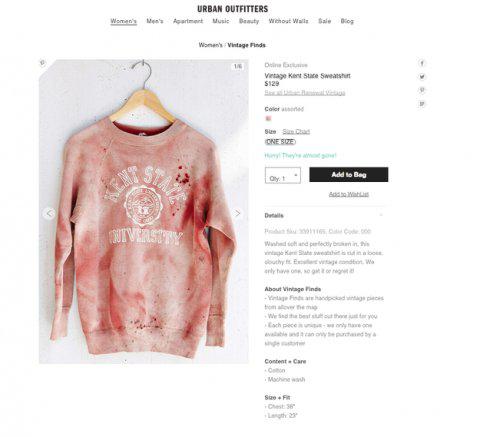This article originally appeared in Business Insider.
Urban Outfitters is facing a public backlash for selling a “Vintage Kent State Sweatshirt” that is spattered with red stains resembling blood. The $129 sweatshirt is reminiscent of the Kent State Massacre of May 1970, when four unarmed college students were killed by the Ohio National Guard during a Vietnam War protest.
This is the latest in a long line of offensive fashion screw-ups by Urban Outfitters. Just within the last year, the company has had to pull three separate items from stores following a public outcry, including a “drunk Jesus” t-shirt, a “depression” shirt and “Lord Ganesh ” socks.
So why does the company keep churning out problematic clothing?
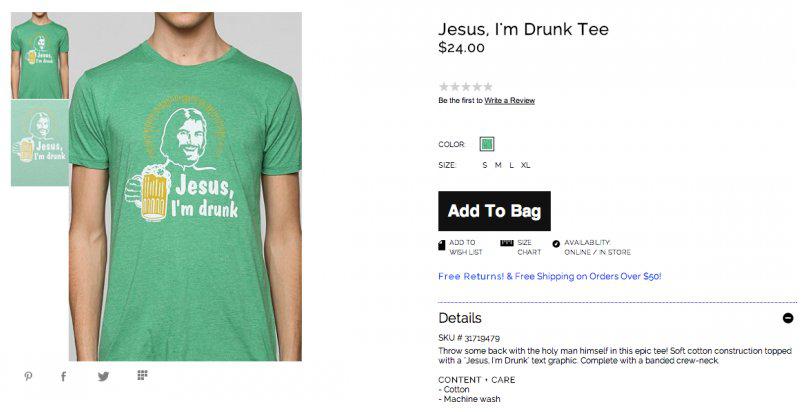
Screenshot/Urban Outfitters
Most of the blame is attributable to how rapidly Urban Outfitters produces and curates new styles, says Howard Davidowitz, chairman of Davidowitz & Associates Inc., a retail consulting agency and investment banking firm based in New York. There are more than 2,000 products available just on the women’s’ sale section of the company’s website. “Given the environment of product development in this super, hyper-competitive business, crazy things are going to slip through,” Davidowitz said. “This is just part of the business and it always will be.” During fashion meetings at major apparel companies like Urban Outfitters, dozens of styles could be approved in a matter of minutes, he said. The Kent State sweatshirt, like other controversial items, could easily be overlooked, he said.
Some critics have wondered, however, whether Urban’s fashion mistakes could be a deliberate campaign for the attention of its core customers: Angsty teens and young adults. Abercrombie & Fitch’s edgy and sometimes offensive styles helped the brand rise to prominence among teens in the early naughts.
In a more recent example, Nine West offended swaths of women with a new advertising campaign that celebrates “husband hunting.“ Critics blasted the campaign as outdated and misogynistic, but branding experts said it was a smart move. “Nine West hasn’t been doing well and they needed to get people’s attention, to cut through the clutter at a very promotional time of year, and get people talking about the brand,” said Aliza Freud, the founder and CEO of brand consulting agency SheSpeaks.
Nine West conceded the campaign was intended to generate buzz. Erika Szychowski, Nine West’s senior vice president of marketing, told the New York Times she expected the campaign to “make noise and get attention.”
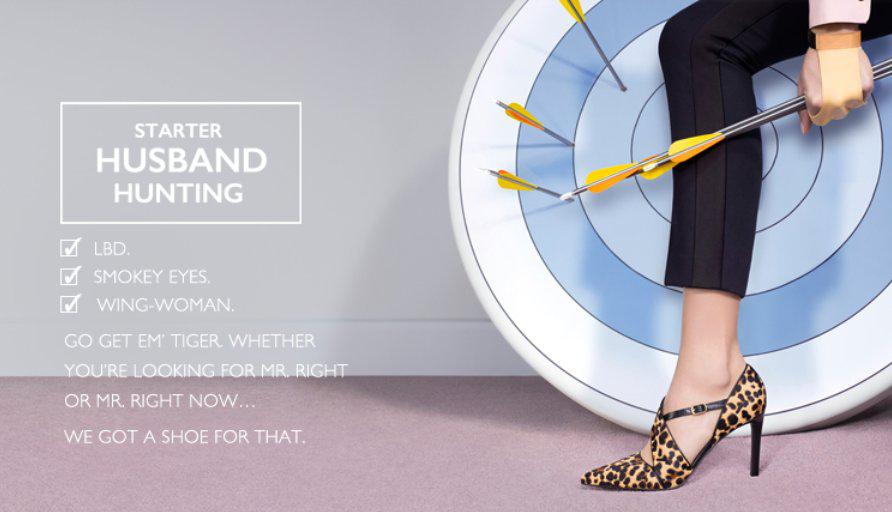
Nine West
“We have to change the way we talk about occasions because women are modern now and shop for a different reason,” Szychowski told the Times. And it worked. At least a dozen national media outlets covered the ads and backlash, including Business Insider, the New York Times, the Washington Post, Businessweek, and Time.
Another notable instance happened in 2008 when the company that makes the pain reliever Motrin began airing a commercial that likened carrying a baby to a painful fashion statement in an appeal to young mothers. “Supposedly, it’s a real bonding experience,” the ad’s narrator says. “But what about me?” The ad recommended Motrin to treat the pain of carrying a child.

Motrin
Outraged consumers vowed to boycott the brand and Motrin was forced to apologize and pull the ads. But the campaign created widespread buzz around the pain reliever, and for that, the ad could be considered a success, Freud said. Within a matter of weeks the outrage simmered and what was left was greater brand awareness.
Like Motrin, most brands that execute this sort of strategy—called shock advertising—tend to suffer only short-term negative consequences, Freud said. The candy company that makes Lemonheads used a similar tactic in May when it launched a terrifying-looking new mascot in an effort to win millennial customers.
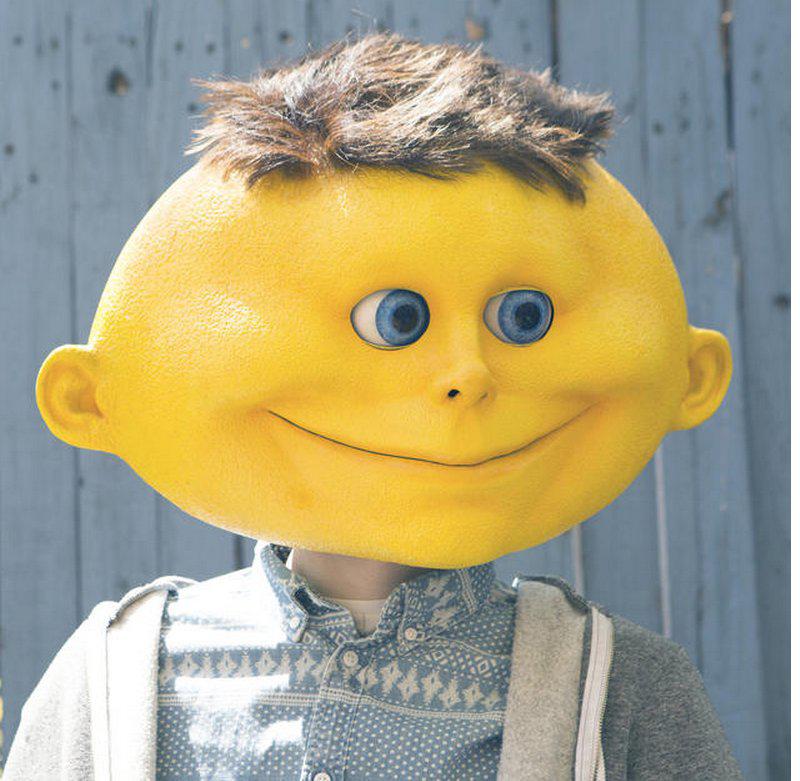
LemonHeads
The strategy worked. Hundreds of people shared images of the new mascot on Facebook and Twitter. (And who could forget the reaction to McDonald’s creepy Happy Meal mascot, released this spring?)
Burger King deployed a “Subservient Chicken” character to similar effect 10 years ago. The character, which is making a comeback this year, is “arguably one of Burger King’s most popular campaigns in the last decade,” according to Ad Age. It began as a man dressed up in a chicken costume who would respond to commands from website users.
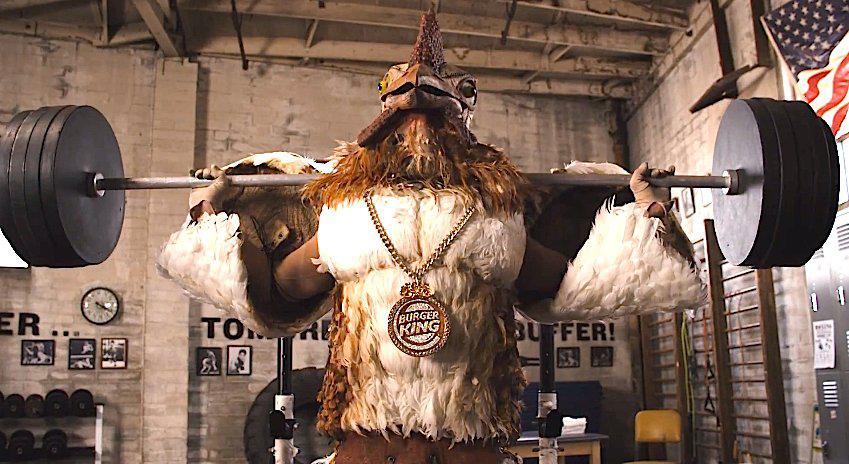
Burger King
The new iteration of the campaign is “apparently a bid to simultaneously court millennials online and general market through TV,” writes Ad Age. In the age of social media, where online sharing can be critical to a brand’s success, such a strategy makes sense.
When it comes to getting customers’ attention, some brands consider any kind of publicity—even if it’s negative—to be useful in spreading awareness.
See Also: The Best Burger in Every State
